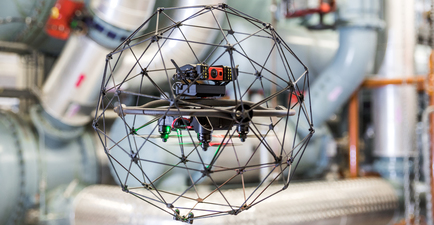ROBINS Project
ROBotics technology for INspection of Ships, aimed at filling technology and regulatory gaps that today still represent a barrier to the adoption of robotics systems in ship inspections
| Business | Time | Project Coordinator |
|---|---|---|
| Marine | Start date: 01-01-2018 End date: 30-06-2021 |
RINA Services S.p.A. |
Challenge
 ROBINS (ROBotics technology for INspection of Ships) is a collaborative project co-funded by the European Commission within the Horizon 2020 EU Research and Innovation programme.
ROBINS (ROBotics technology for INspection of Ships) is a collaborative project co-funded by the European Commission within the Horizon 2020 EU Research and Innovation programme.
The project aims at filling the technology and regulatory gaps that today still represent a barrier to the adoption of Robotics and Autonomous Systems (RAS) in activities related to inspection of ships.
The main advantages in the employment of RAS in ship inspection are the simplified preparation of items to be inspected, with potential reduction of costs, and the safer inspection operation, since the Surveyor is not required to physically access in hazardous or hard to reach areas (e.g. high or very narrow spaces).
The technology gap to be filled is mainly related to the capability of RAS to provide at least outcomes equivalent to those obtained by traditional procedures. On the other side, the regulatory gaps are mainly related to the possibility to verify such equivalence.
To this purpose, the following requirements have been selected:
- Sensing and probing capabilities of RAS are at least as good as the corresponding human personal, direct, sensory experience, or provide equivalent or richer information;
- RAS have the capability to access and adequately explore confined spaces where the inspection is required or desirable, and hazardous, harsh or dirty conditions can be found;
- RAS performance in terms of safety, functionality, dependability and economic viability can be measured, assessed and verified in the required operational scenarios;
- The data collected during inspection activities can be securely acquired, transmitted, archived, maintained and used, with special concern to confidentiality, integrity and availability;
- The data collected during inspection activities, such as photographs, movies or thickness measurement, are made available to end users by means of software tools capable of providing detailed information with adequate presentation and analysis tools.
Approach
ROBINS focuses on two types of RAS: aerial drones and crawlers. Aerial drones are taken into consideration essentially for tasks related to visual inspection, while the crawler is used for thickness measurements and other close-up investigations.
Two main types of operational scenarios are considered in ROBINS:
- Wide volumes with a reduced number of obstacles and irregular surfaces, like cargo holds and cargo tanks;
- Very irregular, narrow, obstacle-rich spaces, like ballast tanks, forepeaks, cofferdams, etc.
The two types of operational scenarios are representative of the two environments where costs and risks connected to inspection activities are more significant:
- Wide volumes with significant heights, like bulk carrier’s cargo holds, require costly access means to reach high places; moreover, large unobstructed heights between levels imply severe consequences for the safety of surveyors in case of casualties;
- Narrow spaces, on the other side, pose hazards related to access, mobility, ventilation, cleanliness, toxic atmosphere, and so on.
The fitness of RAS platforms for their intended purpose is assessed in ROBINS by means of the design, implementation and execution of a set of tests, carried out in a dedicated, specifically designed Testing Facility.
The possibility to test RAS platforms in a controlled and easily accessible environment, where repeatable test protocols can be implemented, considerably increases the development opportunity for new platforms, significantly reducing the costs related to the assessment of their capabilities and to certification activities, if required.
Field trials campaigns are also carried out to assess the reliability, coverage and effectiveness of testing protocols implemented in the Testing Facility, comparing the results obtained in the Testing Facility with those obtained in equivalent trials on-board.
The development of CAD and image processing software tools also play a key role in ROBINS. The software tools developed in ROBINS are expected to devise a 3D model of the confined space subject to inspection by means of image processing algorithms starting from point clouds and photographs, to give the user the possibility to examine accurately the details of interest by moving in the 3D virtual space. The virtual space is also augmented with hot spots and other additional information to ease and speed up the identification of critical or suspect areas in order to provide a valuable guidance to the surveyor.
The level of realism in the representation of inspected spaces is to be such as to allow the user feel a satisfactory degree of presence in the virtual space. The quality of 3D models and augmented VR models, and hence the quality of the user’s virtual inspection, is strictly related to the quality of visual data taken by the aerial drone and additional data coming from probes and sensors carried by the drone or by the crawler. The integration of image-processing algorithms specifically developed for the recognition of ship hull’s critical or suspect areas in the software dedicated to virtual tours, provides a unified environment for virtual inspection.
Conclusion
The iterative approach adopted in the ROBINS project, based on several feedbacks and development loops, is expected to significantly improve the quality of final results, giving valuable means to continuously monitor how effectively the solutions adopted meet the requirements.
The development of robust technical solutions for RAS-assisted ship inspection, based on the understanding of the challenges being faced by asset owners, is expected to streamline wide scale adoption of RAS technology in marine industry.
The final framework of tests, procedures, criteria and metrics can be easily turned into a common, objective, widely accepted regulatory framework for the assessment of RAS for ship inspection, in accordance to the IACS Recommendation 42.
This project has received funding from the European Union’s Horizon 2020 research and innovation programme under grant agreement No 779776
